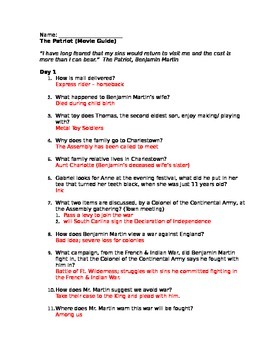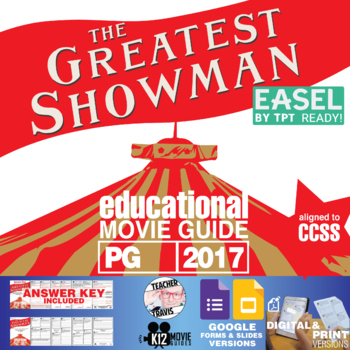Crucible Movie Viewing Guide Questions
The Crucible movie guides allows students to explore the powerful concept of ‘groupthink’ and give them the opportunity to make conclusions on their own about the witch trials that took place in colonial America. The movie guide consists of a 6 page PDF document with 17 high-level short answer and essay questions. Please see the product images for example questions from this movie guide and download a free, complete movie guide for or to see the general quality of my questions and movie guides. K12 Movie Guides are on these other platforms as well:. Is The Crucible a safe movie for my students or my kids? Description The Crucible movie guide is a must have if you are showing this movie in class.
The movie guide consists of 17 high-level short answer and essay questions. An answer key is not included as many questions are open-ended and encourage students to analyze the film by constructing their own meaning from the characters’ dialogue and behavior. This product includes: A student movie guide, PDF print version (6 pages) A student movie guide, PDF digital fillable form version (6 pages) The digital version is for a paperless classroom if your students each have a tablet/iPad. Here is a method that worked for me: 1. Ask students to download a PDF editor app if they don’t already have one.
It needs to have a save function as well. I used Foxit PDF. Host the file. I used google drive to share a folder with the students. After students have completed the movie guide, ask them to save it in a designated google drive folder using a naming convention.
Further Study. Context Quizzes Study Questions. Watch the Video SparkNote. Previous Next. The Crucible (SparkNotes Literature Guide Series). Log in with Facebook The Crucible Questions and Answers The Question and Answer sections of our study guides are a great resource to ask questions, find answers, and discuss literature. The Crucible Movie Viewing Guide: 25 points Directions: Answer all of the questions for full credit. It’s OK if you need to skip some to keep up with the film. It’s OK if you need to skip some to keep up with the film.
(I use LastnameFirstnameMovieGuide.pdf) Please see the product images for example questions from this movie guide and download a free, complete movie guide for or to see the general quality of my questions and movie guides. Students are encouraged to construct their own meaning throughout the film. Arguably, many answers will not fit into a ‘box’. In conclusion, an answer key is not included as many questions are open-ended.

Is a fictional retelling of events in American history surrounding the Salem Witch Trials of the seventeenth century. Yet, is as much a product of the time in which wrote it - the early 1950s - as it is description of Puritan society. The Salem witch trials took place from June through September of 1692, during which time nineteen men and women were hanged at Gallows Hill near Salem, while another man, was stoned to death for refusing to submit to a trial on witchcraft charges.

Hundreds of other persons faced accusations of witchcraft and dozens more languished in jail without trials. As the play describes, the witchcraft trials began because of the illness of, the daughter of the Salem minister, a former merchant in Barbados. Before Betty Parris fell ill, Cotton Mather had published 'Memorable Providences,' describing the suspected witchcraft of an Irish washerwoman in Boston, and Betty Parris' hysteria mirrored those of the suspected Irish witch. Other girls, including Ruth Putnam and also exhibited similar symptoms.
However, actual events diverge from the narrative of the play. The Parris' slave, (who was likely a South American Arawak Indian and not African), immediately came under suspicion. As a form of counter-magic, Tituba was ordered to bake a rye cake with the urine of the afflicted victim and to feed the cake to a dog. This added to suspicions of witchcraft by Tituba, and led to the slave becoming one of the first women accused, along with and Sarah Osburn. Although most of the women first accused of witchcraft were considered disreputable, several reputable members of the community were soon executed, including (featured in the play), and in the most controversial execution, George Burroughs, the former minister in Salem.
One of the most flamboyant of the women executed was Bridget Bishop, a woman who had been married several times and was known as the mistress of two Salem taverns and had a reputation for dressing more 'artistically' than the women of the village. Sir William Phips, the Governor of Massachusetts, created a new court to oversee the witchcraft cases. The Chief Justice of this court was William Stoughton, an avid witch-hunter who permitted many questionable deviations from normal courtroom procedure including the admission of spectral evidence (testimony by afflicted persons that they had been visited by a suspect's specter) and private conversations between accusers and judges. By the early autumn of 1692, the cries of witchcraft began to ebb and doubts began to develop concerning the validity of the charges. Soon, the educated elite of the colony began efforts to end the witch-hunting hysteria that had enveloped Salem.
Increase Mather, the father of Cotton, published 'Cases of Conscience,' which argued that it 'were better that ten suspected witches should escape than one innocent person should be condemned.' Mather urged the court to exclude spectral evidence.
A period of atonement soon occurred in which Samuel Sewall, one of the judges, issued a public confession of guilt and apology, and Reverend Parris admitted errors in judgment. He did, however, attempt to shift the blame to others. (Governor Phips, for instance, shifted the blame to Stoughton, who nevertheless became the next Governor of Massachusetts.) However, Miller wrote The Crucible not simply as a straight historical play detailing the Salem witch trials. Indeed, a good deal of the information in the play misrepresents the literal events of the trial: was not a farmer, not a tavern owner, and during the time of the trials he was sixty years old and only eleven.

Rather, the play has as much significance as a product of the early Cold War era during which Miller wrote the play. Indeed, the play is a parable for the McCarthy era, in which similar 'witch hunts' occurred targeting citizens as communists rather than disciples of Satan. Wisconsin Senator Joseph McCarthy was an undistinguished member of the Senate until February 1950, when he made the public charge that 205 Communists had infiltrated the State department. Upon subsequent testimony before the Senate Committee on Foreign Relations, McCarthy proved unable to produce the name of any 'card-carrying' communists, but he gained increasing popular support for his campaign of accusations. Although he was later denounced, he promoted unfounded accusations and suspicions of communism in many quarters, and is best known for his investigation of communists in the United States Army.
Movie Viewing Guide Worksheet
The House Committee on Un-American Activities (generally known as HUAC) also investigated communism within Hollywood, calling a number of playwrights, directors and actors known for left-wing views to testify. Although some of these, including film director Elia Kazan, testified for the committee to avoid prison sentences, the Hollywood Ten, a group of entertainers, refused to testify and were convicted of contempt and sentenced to up to one year in prison. Over three hundred other entertainers were placed on a blacklist for possible communist views and were thus forbidden to work for major Hollywood studios (many of these were writers who worked under pseudonyms at the time, including Dalton Trumbo and Michael Wilson). Arthur Miller was one of these blacklisted. The blacklist prevented these men from receiving screen credit during this time, until actor Kirk Douglas pushed for Trumbo to receive screen credit for his adaptation of Spartacus for Stanley Kubrick in 1960.
Movie Viewing Guide For Students
How To Cite in MLA Format Ross, Jeremy. Weinbloom, Elizabeth ed. 'The Crucible Study Guide'. GradeSaver, 15 June 2008 Web.